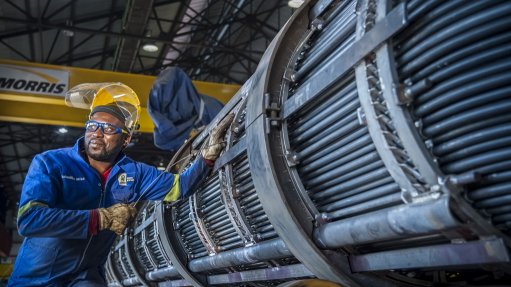
HEAT EXCHANGER APPLICATIONS An assembled tube bundle of a heat exchanger manufactured using explosive welding
Engineering, manufacturing, construction and maintenance services provider Steinmüller Africa offers its clients explosive welding and explosive expansion services. As part of this service, the company has increased its focus on on-site plugging, which enables it to fix leaks in heat exchangers at power stations.
Explosive welding is used to bond dissimilar materials together that cannot usually be welded, such as copper and aluminium, and is generally used to clad plates. Steinmüller, however, has been exploring the use of explosive welding for welding tubes to tubeplates for heat exchanger applications, and has successfully completed the manufacture of five heat exchangers for South African power utilities.
In 2009, Steinmüller Africa signed a technical agreement with UK-based engineering and construction organisation TEi/Yimpact to be the sole licensee of the technology in Southern Africa.
Steinmüller explosive welding manager Hennie Visser explains that two basic conditions must be satisfied for welding to occur with any joining process. Firstly, the surface of the materials being welded must be relatively free of surface films, such as oxides, nitrides or absorbed gases, which can prevent satisfactory joining. Secondly, the materials being joined must be brought into such close proximity that their atoms establish a bond through interatomic forces. These conditions can be met using the explosive welding process.
He describes how a phenomenon known as jetting occurs during explosive welding. Explosives are used under certain controlled conditions that cause the surface films, which are moving along with a thin layer of metals from the unwelded portion of the members being joined, to combine at the point of collision to form a jet.
The jet generated removes the surface films and bonds the materials being joined through the force of the explosive pressure. The detonation rate of the explosive charge will be either subsonic or supersonic, depending on the velocity of sound in the materials being joined.
He notes that Steinmüller Africa conforms to the strict safety regulations laid down by various bodies, such as the police, the fire department and the department of labour, which must be adhered to before explosive welding can be conducted. These are particularly relevant with regard to the explosive-welding faci- lity, which must be approved and licensed as a safe and controlled environment in which explosive processes can be carried out.
“One of the biggest elements that we need to take precautions against is noise. The volume of the charge we can explode in our facility is thus strictly limited to the noise levels and the blast levels that we can contain safely. Hearing protection and noise management are taken very seriously to ensure both the facility and the people are protected. Larger charges need to be exploded in specific, regulated locations,” he says.
Visser further states that, besides the ability to bond dissimilar materials, explosive welding has the added benefit of eliminating the requirement for heat treatment, thereby saving time and making it cost effective in welding processes.